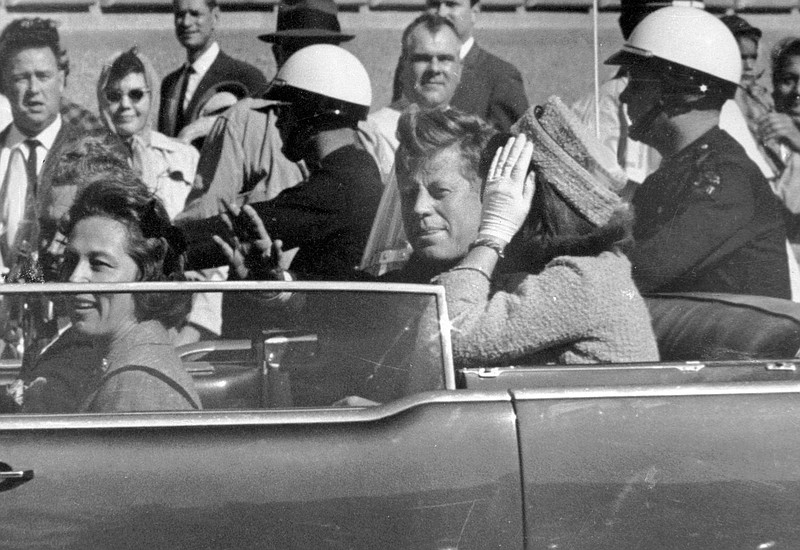DALLAS-Yet again, the National Archives released a trove of records from the Kennedy assassination files on a Friday afternoon, another strange stream of loose ends, dead ends and tangents with little apparent connection to the assassination of the nation's 35th president.
Here and there, the odd curiosity did appear, offering insight into the effort to understand the circumstances of Kennedy's murder but providing nothing to cast the official conclusions into doubt.
The National Archives placed 10,744 records online Friday-documents kept under seal for decades and due for release three weeks ago.
All of the documents come from the FBI's files. The batch includes 144 that had never been released and 2,408 that remain partly classified, with much of the material blacked out 54 years after President John Kennedy's murder in Dallas on Nov. 22, 1963.
To the layman, these large document dumps-thousands of pages at a time-may appear to be impressive feats of government transparency. However many of the documents are copies, or copies of copies, or previously redacted versions of copies. There are no Kennedy assassination bombshells to speak of.
Look at a series of documents in the most-recent batch to see this minutia of duplication.
One file in the National Archives spreadsheet, which organizes the PDF documents, is a translation of a 1972 police report about an American who allegedly tried to pay for a Swiss hotel room with a fraudulent check.
The next document listed is a memo from the Swiss Central Police to an American attache, saying they were sending this police report to the American Embassy.
The third document, in German, is the original police report from Bern, Switzerland.
None of those documents mentions Kennedy, Dallas, Lee Harvey Oswald, Jack Ruby or any of the other major characters in the assassination story.
A memo from April 1977 documents a tip from an IRS informant who claimed that the morning of the assassination, Dallas nightclub owner Ruby called and asked if he would "like to watch the fireworks" with him as Kennedy's motorcade drove through downtown. Two days later, Ruby would kill Oswald.
Ruby's mob connections, and the fact that he died in prison, have long fueled theories that he was part of a conspiracy.
The tipster was an IRS informant whose information on local bookies had been, according to local IRS investigators, generally reliable. The FBI records released Friday leave a cliffhanger. The tipster, identified as Bob Vanderslice, didn't show up for an appointment and apparently ducked the FBI for several weeks.
There's a one-page memo from an assistant director of the Royal Canadian Mounted Police dated Dec. 17, three weeks after the assassination, informing the FBI that at the Cuban Embassy in Ottawa, news of Kennedy's death was met with "jubilation." The Mounties' tipster also passed along that Cuba's foreign minister instructed diplomats in Canada to keep such jubilation to themselves.
The material reflects myriad leads the FBI pursued for decades, based on tips of varying levels of credibility and detail.
As with previous releases, it's unclear how some of the documents relate to the Kennedy assassination directly.
For example, some of the never-before-released files include letters from blacklisted Hollywood screenwriter John Howard Lawson to East German officials about film critique and potential scripts.
A memo released Friday from 1988 refers to a claim by jailed French mobster Christian David, who maintained that three Corsican assassins were involved in Kennedy's murder. The FBI's legal attache in Paris wrote that David's attorney, Henri Juramy, had provided a sealed envelope, to be opened only if he were set free.
David was facing trial for the 1966 murder of a French policeman.
"The envelope contains the name of the third person involved in the assassination of President John F. Kennedy," the memo reads. "Legat (legal attache) Paris considers the merits of Juramy's proposal suspicious" and recommends bringing in an FBI agent "well backgrounded in the Kennedy assassination investigation to make a determination of the relevance of his sources and information."
This is the fifth release of records this year. A 1992 law gave federal agencies 25 more years to release all remaining Kennedy files. The deadline was Oct. 26. President Donald Trump agreed to another six months of review after last-minute appeals, mostly from the CIA and FBI, citing the potential for irrevocable damage to national security.
Dozens of the newly released FBI memos deal with efforts to monitor anti-Castro Cuban exiles in South Florida. Names that come up include Max Lesnik, a former friend of Castro who was exiled after a falling out with the dictator.

